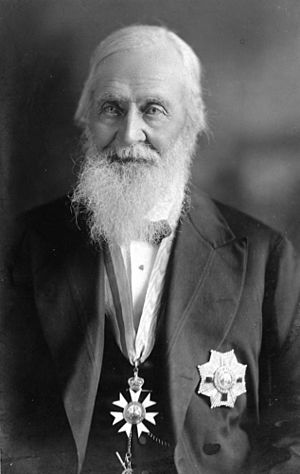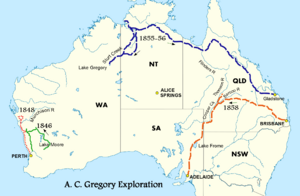Augustus Charles Gregory facts for kids
Quick facts for kids
Sir Augustus Gregory
|
|
|---|---|

Augustus Charles Gregory, c. 1903
|
|
| Member of the Queensland Legislative Council | |
| In office 10 November 1882 – 25 June 1905 |
|
| Personal details | |
| Born |
Augustus Charles Gregory
1 August 1819 Farnsfield, Nottinghamshire, England |
| Died | 25 June 1905 (aged 85) Brisbane, Queensland, Australia |
| Resting place | Toowong Cemetery |
| Nationality | English Australian |
| Relations | Joshua Gregory (father), Francis Thomas Gregory (brother) |
| Occupation | Surveyor |
| Known for | Exploration of Australia Surveyor General of Queensland |
Sir Augustus Charles Gregory (born August 1, 1819 – died June 25, 1905) was an important explorer and surveyor in Australia. He was born in England but spent most of his life exploring and mapping parts of Australia. Between 1846 and 1858, he led four big expeditions. He also became the very first Surveyor General of Queensland, which meant he was in charge of all the land surveying in the new state of Queensland. Later, he was made a member of the Queensland Legislative Council for life, helping to make laws.
Contents
Early Life and Family
Augustus Charles Gregory was born in Farnsfield, England. He was one of five brothers. His brother, Francis Thomas Gregory, also became a well-known explorer.
Augustus was taught at home by tutors and his mother. In 1829, when he was about 10 years old, his family moved to Western Australia. They sailed on a ship called the Lotus and arrived just four months after the Swan River Colony was started.
The Gregory family first received land near the Swan River. However, the soil was not good for farming. They later got more land in other areas. During the 1830s, Augustus took different jobs to help his family earn money. He worked for a chemist and also as a surveyor with his brother Joshua. In 1841, he started working for the government's Survey Office.
Amazing Explorations
Augustus Gregory led several important expeditions across Australia. These trips helped to map and understand the country better.
First Expedition (1846)
In 1846, Augustus went on his first exploration with his brothers, F. T. Gregory and H. C. Gregory. They took four horses and enough food for seven weeks. They started from a station northeast of Perth and explored a large area north of the city. They traveled 953 miles (1534 km) in 47 days.
Gascoyne River Expedition (1848)
Two years later, Gregory led a trip to explore the Gascoyne River area. He was looking for new pasture-land, which is land suitable for grazing animals. The group left in September 1848 and crossed the Murchison River. The land was very dry, making it hard to find water for the horses. Gregory decided to turn back in October. They returned to Perth in November, having found some good pastures. Even with water problems, they covered about 1500 miles (2414 km) in 10 weeks.
North Australian Expedition (1855-1856)
In 1854, Gregory was asked to lead a big expedition into the interior of Australia. This trip started from Moreton Bay near Brisbane. His brother, H. C. Gregory, was second in command, and Ferdinand von Mueller, a famous botanist (plant scientist), joined them. There were 19 men, 50 horses, and 200 sheep.
The group sailed from Moreton Bay in August 1855. Their ship got stuck on a reef for several days before they could continue. They reached the Victoria River estuary in September. The party split up, with one group going up the river by boat and Gregory leading the other over land. During this trip, Gregory's group met the Gurindji people, who had never met Europeans before.
Gregory also hired John Gilburri Fahy as a guide. Fahy had lived with Aboriginal people for many years and knew the bush well. Gregory promised Fahy a full pardon for past actions if he helped find traces of the missing explorer Ludwig Leichhardt. Fahy received his pardon in 1857.
The groups reunited in October, setting up a camp near today's Timber Creek. Gregory explored the Victoria River and followed Sturt's Creek for 300 miles (483 km) until it disappeared into the Tanami Desert.
On July 2, 1856, Gregory carved an inscription on a large boab tree, now known as Gregory's Tree. This mark showed where he left a letter in case his team got lost. The group then traveled east, exploring several rivers like the Elsey, Roper, and Macarthur. They returned to Brisbane in December 1856, after surveying a huge area of land. In 16 months, the expedition had traveled over 2000 miles (3219 km) by sea and 5000 miles (8047 km) by land!
Search for Ludwig Leichhardt (1857-1858)
In September 1857, the government of New South Wales asked Gregory to search for Ludwig Leichhardt, another explorer who had vanished. Gregory led a team of nine men, including his brother C. F. Gregory.
The expedition started in March 1858. In April, they found a tree marked with an "L," which was a sign left by Leichhardt. They followed the Barcoo River and then the Thomson River. By May, the land was so dry that they had to turn south to save their horses. They followed Cooper Creek and reached Strzelecki Creek in June. Gregory decided to continue south to Adelaide, arriving there at the end of July 1858.
Later Life and Achievements
After his major explorations, Gregory took on important roles in Queensland.
He became the Surveyor General of Queensland in 1859. This meant he was responsible for all land surveys in the new colony. He also became a geological surveyor, studying the Earth's structure.
In 1862, he built his own farmhouse called Rainworth in Brisbane. This house is now a heritage-listed building. He lived there until he died.
Gregory was also very involved in his local community. From 1880 until his death in 1905, he served as a councillor and later an alderman for the area of Toowong. He was the shire president for 12 years and the town mayor in 1904.
On November 10, 1882, Gregory was appointed a member of the Queensland Legislative Council. This was a special appointment that lasted for his entire life, allowing him to help make laws for Queensland.
He was interested in science and was a trustee of the Queensland Museum. In 1884, he published a book with his brother, F. T. Gregory, called Journals of Australian Exploration, which shared their travel stories.
In 1903, Gregory was knighted by the King, becoming a Knight Commander of the Order of St Michael and St George. This was a high honour given for his long service as Surveyor-General and his work in the Legislative Council.
Sir Augustus Gregory passed away on June 25, 1905, at his home Rainworth in Brisbane. Many people came to pay their respects at his funeral. He was buried in the Toowong Cemetery in Brisbane. After his death, his home Rainworth was moved to a new location and is still standing today.
Honours and Legacy
Many places in Australia are named after Augustus Gregory to honour his contributions:
- The Electoral district of Gregory, a voting area in Queensland.
- The town of Gregory, Western Australia.
- The Gregory River in Queensland.
- The town of Gregory, Queensland.
- The Gregory Highway in Queensland.
- Mount Augustus and Mount Augustus National Park in Western Australia.
Even a road in his birthplace of Farnsfield, England, called "Gregory Gardens," is named after him.
His home, Rainworth, also gave its name to:
- Rainworth, Queensland, a suburb in Brisbane.
- Gregory National Park, a large park in the Northern Territory.
Several plants are also named in his honour:
- Adansonia gregorii, known as the Boab tree.
- Brachychiton gregorii, known as the Desert kurrajong.
- Cochlospermum gregorii, a type of native Kapok tree.
| Awards | ||
|---|---|---|
| Preceded by Robert Logan Jack and Robert Etheridge, Jr. |
Clarke Medal 1896 |
Succeeded by John Murray |
Images for kids
-
The grave of Sir Augustus Charles Gregory at Brisbane's Toowong Cemetery.
See also
 In Spanish: Augustus Charles Gregory para niños
In Spanish: Augustus Charles Gregory para niños









